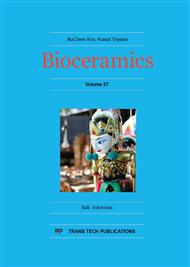p.151
p.157
p.161
p.165
p.171
p.177
p.183
p.187
p.192
Thin Degradable Coatings for Optimization of Osteointegration Associated with Simultaneous Infection Prophylaxis
Abstract:
The colonization of biomaterials with bacteria represents the main cause of implant-associated infections. Both an antibiotic prophylaxis and a faster osteointegration can be obtained by incorporation of bactericidal active metals in degradable CaP coatings. At present there is no reliable method on the basis of thermal spraying to get thin homogeneous layers containing silver, copper and bismuth in bacteriostatic / bactericidal concentrations. The aim of the study was the development and optimization of high-velocity suspension flame spraying (HVSFS) process for producing thin resorbable bioactive ceramics coatings on the basis of degradable calcium phosphates. In these layers the bacteriostatic / bactericidal effective metal copper should be integrated. Cells were grown on the materials for 3, 7, 14, and 21 days. Live/dead assay was used to measure cell viability. The in vitro cytotoxicity was determined by the microculture tetrazolium (WST) assay. Cell morphology, cell attachment, and cell spreading were investigated using laser scanning microscopy and raster scanning electron microscopy. All substrates supported sufficient cellular growth for 21 days and showed no cytotoxicity. On each material an identical cell colonisation of well communicating, polygonal, vital cells was verified
Info:
Periodical:
Pages:
171-176
Citation:
Online since:
May 2016
Price:
Сopyright:
© 2016 Trans Tech Publications Ltd. All Rights Reserved
Share:
Citation:


